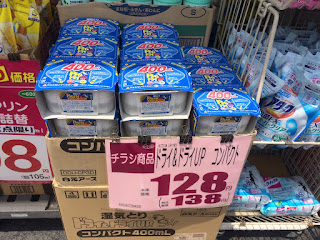
The
bentō (弁当) or lunchbox is a familiar word both inside and outside Japan. In Japan, it usually contains rice with a variety of small compartmentalised side-dishes (
okazu =
おかず) such as meat, fish, pickles, or vegetables which may be eaten warm or cold. The picture below right shows a typical
bentō shop which promotes "one coin" (ワンコイン) lunchboxes (advertised left), that is lunchboxes for ¥500.

At the vast majority of public elementary and junior high schools (as well as many kindergartens) lunch, known as
kyūshoku (給食) - literally "gifted" or "granted" food - is provided. This is typically shuttled in from an outside factory to each school though some municipalities (like Kodaira) prepare the meals in the schools themselves. Students will take it in turns to be the
kyūshoku tōban, that is the person who brings the lunch to the classroom and dishes it out to their classmates (usually decked out in smock and hat). Generally, students will take their lunch (with milk) back to their table and wait until everyone has their meal before starting. The teacher usually eats with the students too. Many private schools, however, and all high schools will not have
kyūshoku so a
bentō has to be prepared at home (again, usually by the mother) or (for high-schoolers only) a cafeteria or convenience store lunch may be an option.
Whether a school has
kyūshoku or not can be a key point for a busy working mother for whom preparing a
bentō each morning can be a thankless task that requires getting up early and producing a lunchbox that is both nutritious and will stand up to the scrutiny of teachers, classmates, and even other parents. Indeed, for some parents, making the perfect
bentō can be a point of pride and
bentō pictures are a mainstay on social media. Pressure to make a
kyaraben or character bentō, a lunchbox featuring a popular cartoon character (such as Hello Kitty or Pikachu) or perhaps an animal (pandas are popular), partly for the purpose of encouraging a fussy child to eat, can put extra pressure on already over-worked mums. Japanese
Cookpad has over 30,000 recipes for
kyaraben.
 |
| Click to preview on amazon |
For an academic analysis of the
bentō , see chapter 4 in Anne Allison's
Permitted and Prohibited Desires (2000) titled, "Japanese Mothers and
Obentōs: The Lunch Box as Ideological State Apparatus." In this chapter, she describes how the social pressure on mothers to prepare
bentōs and perform other domestic and family work perpetuates the gendered division of labour that effectively limits women to low-paying, part-time jobs.































